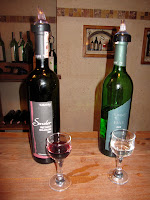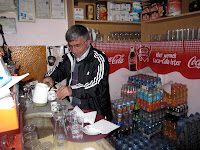


Similar to other grand Cuisines of the world, Turkish food is a result of the combination of three key elements:
#1: Abundant agriculture and sea life, and a mix of regions in close proximity, creating different specialties.
#2: The legacy of an Imperial Kitchen. Hundreds of cooks specializing in different types of dishes, all eager to please the royal palate, makes for inventive cooking!
#3: Turkey was the crossroads of the Spice Road, where ingredients and cultures mixed robustly. Just check out the Spice (also called Egyptian) Bazaar:
All turkish food is based on Ottoman traditions, but it is not a homogenous art. Aside from a few Turkish specialties that are found throughout the country, most regions have their own specialty:
The Black Sea region in northern Turkey uses corn and anchovies -- The Southeast, like Ufra and Adana, is famous for its kebabs, mezes (or appetizers) and baklava -- Western parts of Turkey, where olive trees are grown abundantly, transfuses all dishes with its famous olive oil -- and along the Mediterranean, the food is predictably rich in vegetables, herbs, and fish. Central Anatolia is famous for its pasta specialties, such as manti (ravioli from Kayseri) and keskek (Persian barley stew)
Throughout all these regions, the foundation of all Turkish food is a white dough.
It is most commonly baked into Simit (sesame seed rings commonly enjoyed with your morning coffee or as a street snack)
and Borek (thin sheets of pastry used in a bunch of ways but usually layered and baked with cheese).

You’ll also be served ekmek, or white bread--manti, or dumplings -- – and pide (which we call pita), or flat bread, like this kebab is wrapped in, above right.
On a typical Turkish meal in Istanbul, your culinary journey will look something like this…
You’ll start with Raki. It’s the official national drink of Turkey, where drinking is never a hurried, loud, boisterous, or a lonely affair, but rather a communal, gently festive and cultured way of entertainment. Raki is made from anise seed and served, with a side of chilled water, with your mezze.
Mezzes, or appetizers, come next. Like Spanish tapas, you can often mix-n-match from a large menu or buffet, but Mezzes have a very different flavor than their Spanish counterparts. Choices usually include dolma (what we call grape leaves) and kofte (meatballs).
There’re always seafood offerings, like kalamar (squid), cod roe, or stuffed mussels:
There are sides of hummus, your compulsory Borek (fried puff pastry with white cheese, which is also called ladyfingers or cigarette rolls, photograph above), all garnished with boiled egg halves, fava beans, cold eggplant salads, sliced ripe melon, acili ezme (hot pepper paste often with walnuts), and kalamata olives... all served with slices of grilled or garlic bread.
Your main course is often Kabobs. Cooked on skewers, these date from when nomadic Turks used to cook their meat and breads (borek) over camp fires.
Some are cooked in a clay pot. You'll see them lined up along sidewalk tables, an Istanbul version of fast food, but pictured below, the kebab is in a restaurant where our waiter will slice open the sealed top and serve us.

Lamb and spicy beef are some favorite kebabs -- usually served with Yogurt.
Seafood is popular, with four seas (the Black Sea, Marmara Sea, the Aegean, and the Mediterranean) surrounding the Turkish landscape.
Fish restaurants are all over Taksim Square
And women shop in the Grand Bazaar for fish for their home kithens too.
Each region, and season, has its own recipes. On the Bosporus, you can get your sea bass grilled over charcoal on the back of the boat!
"Hamsi", though, is the prince of all fish known to Turks. They say that the Black Sea people know forty one ways of making hamsi, including hamsi börek, hamsi pilaf and hamsi dessert!
You can check out fish taverns along the Bosporus… they’re always open air, taking up space right by the sea, tables seaside. It is customary, at these taverns, to visit the kitchen to pick out your fish.
Another main course is often Manti… dumplings of dough filled with a special mix of meat, and served with yogurt as a heavy Sunday lunch affair, and all kinds of other meats can be purchased at the Grand Bazaar.
Pilav- like our rice pilaf, but lumpier – is a common “side”.
And yogurt is a key ingredient all along the way – with meats like kebabs and kofte, vegetables like eggplant, mezzes and mantis and more. In fact, the English word yoghurt, or yogurt, derives from the Turkish word yoğurt
Wine is enjoyed throughout Turkey (except during Ramadan), but the cost of a lavish dinner is often less than the cost of the wine that accompanies it. To sample the country's finest, you can tour vineyards, like this one in Cappadocia.

Wine has a long history in this region. The peoples of the Byzantine Empire enjoyed their wines and developed careful cultivation methods for their grapes. Then, under the Ottoman Empire, the Sultan's Muslim subjects largely abstained, but his Christian and Jewish subjects continued to make and drink wine.
With the fall of the empire (1923) and founding of the European-style Turkish Republic, many citizens of Greek heritage moved to Greece, but in the secular republic wine-making was encouraged.
Want a special wine decanter? Check out the pottery in Avanos where they hand spin wonderful wine vessels at Chez Gilep!

Turkish coffee is not a specific variety of bean, but rather a method of preparation. Turkish Coffee is prepared by boiling finely powdered roast coffee beans in a pot (cezve), possibly with sugar, and serving it into a cup, where the dregs settle.
Turkish coffee shops are found in amazing hidden corners of the countryside, and city:
Commons desserts are either fresh fruit (following the seasons… strawberries in spring to peaches and melons in summer, and pears and quince in fall, then mandarin oranges in winter.
Or milk desserts, called the “muhallebi” family of desserts, spotlight puddings, made without any eggs or butter, in a wide variety of flavors including rose-water!
There's lokma, or fried dough, and gozleme, which can also be cooked in syrup, topped with pine nuts and heavy cream, for a dessert crepe!
Honey desserts, like "baklava", are the generic cousins of a dozen or so sophisticated sweet pastries with names like twisted turban, sultan, saray (palace), lady's navel, nightingale's nest.. Check out these pistachio baklavas! 
Turkish delights, 

Ferman... which were the nighttime sweets on my pillow at Sumahan On the Water (http://www.sumahan.com) is a turkish almond paste, similar to what we know as marzipan. It's a confection that goes way back to the Ottoman Sultans of Edime, the capital of the empire before Istanbul.
And I couldn't resist trying the Turkish Ice Cream, too! It’s deliciously flavored, but more gummy than I was expecting.
As a little sidewalk snack, you’ll find juice bars everywhere, and pomegranate juice is the newest trend!
Pumpkin seeds, a staple crop from Cappadocia in central Turkey, make a salty accompaniment, or you can stop at a nut bar, like this one, in the shadow of the Galata Tower.
To get the best kebab in the Grand Bazaar, go here:
To dine of the best kofte in the city, try there:
And to taste these native specialties, look for a “Lokanta”, a local lunch joint: the Haci Salih, at Istiklal Caddesi, in Istanbul, is a great stop!


Haci Salih Lokantasi, Istiklal Caddesi, Istanbul, Turkey 0212 243 4528


















No comments:
Post a Comment